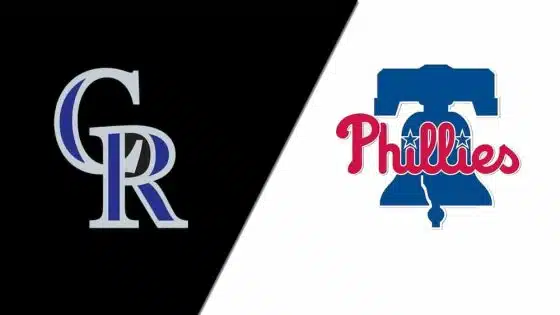By: Jason Ferrie, Sports Talk Philly Columnist
The Philadelphia Phillies will continue their rebuilding process in 2017, and hope that third baseman Maikel Franco continues to develop into a potential cornerstone piece.
Since he was in the minors, there has been hope that Franco could be the club's long-term third baseman. To this point, Franco has played in 248 games and struggled for stretches during that time. While he was been better than replacement level in both 2015 and 2016, Franco has struggled to adjust to off-speed pitching. In order to take the next steps forward, the 24-year-old will need to make adjustments and alter his approach.
If you followed Franco through the minor leagues you would know that he was projected to be a good power bat, grading out as 60 on the 20-80 scouting scale, according to FanGraphs. The issue for the young Phillies third-baseman has never been power, but rather the ability to adjust to off-speed pitches. ESPN’s Keith Law noted that Franco had showed some major deficiencies in his game while playing in the Eastern League:
“Franco is a right-handed hitter who gets his hands very high and deep at the plate, nearly locking his right elbow right before he brings his hands forward, and his above-average bat speed can only go so far in getting the bat head to the zone in time. He's very strong and when he gets his hips started early enough he's got 65 or 70 raw power (on the 20-80 scouting scale), although the timing of his hip rotation varies from pitch to pitch.
His approach, however, is a disaster right now — not only does he struggle to recognize off-speed stuff, especially changeups, but he's only interested in pitches he can crush, making no adjustments to where the pitch is located or to its type. If you signal that you're just trying to murder fastballs, you're not going to see many fastballs in the zone. That approach shows up in his lack of patience, with just one walk in Reading, on June 23, but it will show up soon enough in his batting average, as well.”
This statement by Law has remained true for Franco to this point in his major-league career. Even when Franco posted a 129 wRC+ in 2015, he hit just .194 against curveballs and .259 against sliders. The plus side for Franco in 2015 was that while he hit for a generally low (decent versus sliders) average against these pitches, when he made contact, he did damage. Against the curveball, he slugged .417 with a .286 isolated power. He was even better against the slider, slugging .569 with a .310 isolated power. The power numbers aren’t shocking as good power hitters tend to do damage with mistakes—which Franco certainly did. However, teams picked up on the lower averages and continued to attack the young power hitter with off-speed throughout 2015.
Also Read: Hall of Fame or not, Phillies should retires numbers of Utley and Rollins
In his second-year of Major League exposure, Franco saw either a slider or curveball on 31-percent of pitches, according to BrooksBaseball.net. It wouldn’t be as large of an issue if Franco did damage with those off-speed pitches, but he didn’t, especially last season. In 2016, his slugging percentage on sliders dropped to .365 with a .161 isolated power. On curveballs, Franco slugged just .245 with a .082 isolated power. Those numbers won’t play going forward. Teams will attack Franco with off-speed until he proves he can handle it.
As far as how teams have approached Franco in his first two seasons, right-handed pitchers have attacked him with either a curveball or slider on 32-percent of first pitches while showing him a first-pitch four-seam fastball on 33-percent of first pitches. Franco has seen an even greater amount of curveballs and sliders, jumping to 38-percent when the pitcher is ahead or has two strikes. When the account is even, the four seam to curveball/slider distribution is about even at 32-percent to 33-percent. There isn't a high likelihood that this distribution will change going into the 2017 season.
With left-handed pitchers, Franco actually gets a curveball or slider on 24-percent of first pitches compared to 35-percent of fastballs. When Franco gets ahead, four-seam to curveball/slider distribution stays at 35-percent four seam and drops the curveball/slider to 13-percent. However, this is a spot where left-handed pitchers have utilized their change-ups. The only time Franco gets close to an even curveballs or sliders to fastball distribution is with two strikes. It does appear that left-handed pitchers have gravitated toward using their change-up to Franco, throwing it in all counts with it becoming their most commonly thrown two strike pitch to the slugger in 2016.
The heatmaps below represent that teams are currently and will most likely continue to attack Franco low and away with the curveballs and sliders as they have the past two years. The top heatmap represents the curveballs and sliders thrown to Franco during his 2015 season, followed by 2016 right below:
It certainly makes sense to make Franco adjust, and if you look at his spray chart, he has yet to hit an opposite field home run on a curveball or slider. So why not try to locate more curveballs and sliders on the outer portion where he isn’t hitting them over the fence? It is certainly something that will continue to happen in 2017 and beyond if Franco doesn’t adjust.
To this point in his major-league career, Franco is actually struggling to produce on off-speed pitches from left-handed pitchers as well. Franco is hitting just .161 with a .323 slugging percentage against left-handed sliders and .129 with a .226 slugging percentage against curveballs since he has been in the majors. The sample sizes are somewhat small (210 pitches), but it is something to follow into heading into this season.
Phillies Roundtable: Will Maikel Franco hit over 30 home runs in 2017?
The hope heading into 2017 is that new hitting coach Matt Stairs will be able to work with the young Franco and help him to solve some of his early issues. Stairs has said that he would like Franco to remain aggressive but work on taking some walks this season. Sometimes young hitters can give away at-bats early in their career and Stairs has also noted that he wants Franco to minimize those instances. Confidence in Franco is something that Stairs does not lack, even comparing him to former American League MVP Miguel Tejada, who was a low on-base player with 30 home run power early on in his career.
Last season, Franco finished the season with a .733 OPS—which ranked 19th in MLB among qualified third-baseman. Along with that, he finished with a 92 wRC+ (100 is league average), which tied for 21st among third-baseman. Both of these numbers are in the bottom-third of players at his position and the Phillies will need Franco to significantly improve those numbers back toward his 80-game stint in 2015. If Maikel Franco can make the adjustments at the plate to raise his on-base percentage while hitting for plus-power, the Phillies will be in good position with their young and upcoming talent.





